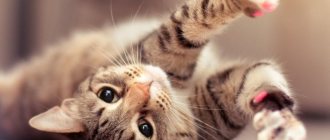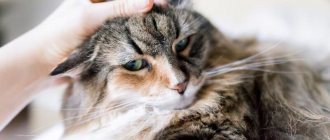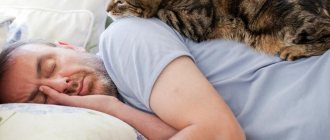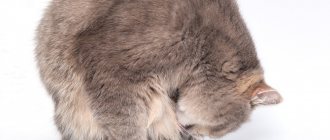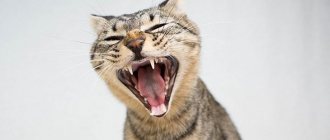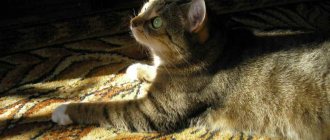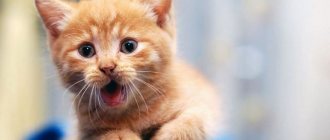Behavioral instincts
Most cats turn out to be real clean people and are willing to spend a lot of time licking their fur. This behavior is driven by natural instincts:
- Cleaning up after the hunt . Cats are predators, so after meals they need to remove the blood of their “prey” from their coats.
- Calming effect . This procedure calms the animal and relieves stress. It is believed that by cleaning the fur with their tongue, cats lick vitamin B from it, which is necessary for normalizing psychological balance.
- Disguise method . Washing is not just a standard ritual; cats use it to mask their scent. This allows wild animals to remain undetected for as long as possible during the hunt.
- Protective reflex . With their rough tongue they distribute fatty lubricant - secretory lard, which protects the coat and gives it elasticity.
- Purity. Licking is also a hygienic procedure, as a result of which cats keep their fur clean, including in the intimate area.
Fur coat length. As a rule, hairless and short-haired pets are easier to care for their skin and coat. But the owners of a luxurious, long fur coat are less fortunate. Often, access to “that very” place is difficult for them. And if a long-haired pet suddenly begins to “ride” along the floor on the “fifth point”, choosing rough surfaces, then it is worth looking under its tail and assessing the condition of the fur in this place. Perhaps dirt, fecal particles have stuck to it, tangles have appeared, or foreign objects, such as plant twigs, have become stuck.
Helminths in cats
This problem is most often encountered by either very young kittens or naturally fed animals.
Insufficiently processed meat and fish retain worm eggs, so infection of a pet can occur even if the cat is not outside. Treatment consists of taking anti-worm medications. Such medications are toxic and can cause poisoning of the animal, so they must be selected by a veterinarian.
It is necessary to take your pet to the doctor and undergo a stool test, based on the results of which the veterinarian will select the optimal drug for treatment.
In some cases, simultaneous anthelmintic therapy may be required for all family members and other animals living in the house, since worm eggs easily enter the body upon contact with an infected animal.
Diarrhea is one of the reasons for “riding on the butt”
Cats suffering from diarrhea may clean their butts on the flooring, carpet or other rough surface. In this case, the behavior of the animals has nothing to do with the quality and length of their fur. Thanks to friction, the pet tries to solve two problems at once:
- Get rid of extraneous, unpleasant odor.
- Eliminate itching sensations that occur due to irritation of the mucous membrane in the anal area.
Treatment. When the cat does not have frequent bowel movements, but is bothered by itching, veterinarians recommend using rectal suppositories that have enveloping and antibacterial properties.
During the recovery period, the animal should not push too hard, so it is prescribed a light diet.
Oops, there's something there
The most common reason that a cat sits on its butt and goes on its way is an unsuccessful bowel movement. A furry cat may have waste products stuck to the fur around his anus, and he may try to get them off by rubbing them against the carpet. At the same time, in any animal, feces can get stuck in the anus for a variety of reasons, and the cat, looking around and assessing the size of the “problem,” may decide that it is wiser not to lick the butt, but to first wipe it on the floor.
In this case, there is no need to be particularly concerned, although it is worth observing the animal. If this happens frequently, consider trimming your cat's fur around the anus if feces are getting stuck there, or choosing a higher fiber food if they get stuck at the exit. In addition, she should always have access to water, which is necessary for easy bowel movements.
Possible pathological disorders
Unfortunately, diarrhea and dirty fur are not the only factors that cause a cat to ride on its butt. There are also more serious factors that lead to this behavior, for example:
- mental health disorder;
- post-traumatic stress disorder;
- helminthic infestation;
- paraanal inflammation.
Each of the diseases deserves attention and requires consultation with a veterinarian. In addition, they are accompanied by other symptoms, in addition to “travels on the fifth point”.
Signs of mental disorder
With mental disorders caused by stress, the pet's behavior changes noticeably and becomes strange. The cat can:
- show aggression;
- avoid communication, including with the owner;
- lose appetite.
The owner may notice that the pet begins to crawl on the floor, regardless of toilet procedures. In this case, it is recommended to immediately contact a specialist who will identify the pathology and prescribe appropriate therapy.
Phantom pain syndrome
After an injury to the hind legs or a fracture of the hip joint, the pet begins to look for a way to eliminate phantom soreness. He rolls on the floor, trying to get rid of the pain that is lingering in his brain. In such a situation, veterinarians prescribe medications that have a mild sedative effect to the animal. They help him cope with excruciating post-traumatic discomfort.
Parasite infestation
Most often, pets get pinworms and tapeworms, which live in the large intestine. To reproduce, many of them have to crawl to the entrance to the anus to lay eggs. This process is accompanied by a feeling of severe itching, which the pet tries to get rid of by crawling on the floor.
When infected with tapeworms, a feeling of bloating occurs in the intestines. The cat strives to get rid of feces, stimulating the anus while riding on the floor and causing defecation. To save your pet from such difficulties, you should regularly deworm it, using anthelmintic drugs for preventive purposes. These can be tablets for oral administration, drops on the withers area or other means.
Blockage of the anal glands
Mustachioed striped animals have anal glands, which are muscular sacs located in close proximity to the anus. They constantly produce secretions that are released through the ducts during bowel movements. It gives feces and urine a specific odor, allowing cats to leave “fragrant” marks on their territory.
Norm and deviations. In its normal state, the secretion is a thick, odorous substance. If the glands are not completely emptied, then corresponding disorders arise:
- the tissues of the muscle sacs are “overstretched”;
- irritation occurs in the glandular ducts;
- dermatological problems arise - small inflamed seals and bald spots form in the neck and along the spine;
- the paraanal glands swell greatly and become visible under the animal’s tail.
Consequences. If the owner does not pay attention to the blockage in time, then the disruption of circulation ends with the formation of a fistula and the penetration of the contents of the glands into the peritoneum.
Methods for cleaning the anal glands
Veterinarians can help you deal with the problem of blocked anal glands. Moreover, representatives of some breeds require regular cleaning - 1-2 times every 4-5 weeks:
- The veterinarian, using mechanical force, cleans the ducts, removing excess or thickened secretions.
- If the wounds are infected and inflamed, the cat is prescribed a comprehensive treatment: antibiotics, diet food and rectal suppositories.
- In case of advanced disease, when the mucous tissues are necrotic, surgical intervention is necessary. The affected membranes are excised.
There is a possibility of relapse, so it is recommended to visit the veterinary clinic periodically.
Preparing for DIY Cleaning
You can also clean the anal glands yourself by carefully squeezing out the secretion.
It is important to consider that the liquid is very odorous and you should properly prepare for the procedure:
- put on special clothes;
- use rubber, silicone or latex gloves;
- Place a stack of gauze napkins nearby.
Algorithm of actions. The process of cleaning the glands is carried out in stages:
- The animal is fixed. You can swaddle it for these purposes, leaving the area around the tail free.
- The tail is pulled to the side, opening the anus.
- With two fingers, press on the place just below the anus, using a napkin. As a result of a successful procedure, secretory fluid will be visible on the material.
- The movements should be continued until the gland sacs are completely cleared of secretion.
If the contents are too thick, you will need to insert a finger into the anus to remove it. The thumb presses on the gland from the outside, and the index finger applies pressure from the inside.
A cat riding on its butt is a strange and at the same time funny sight that makes inexperienced owners smile. But an owner with experience cannot be deceived; he knows that something is bothering the pet and he needs to help him as soon as possible. And to eliminate the risks of serious consequences, it is better to contact a professional.
Poor diet and low mobility
Common factors leading to butt riding include:
- physical inactivity;
- excess body weight;
- high-calorie foods.
Unfortunately, even among cats there are often lazy people who lead a sedentary lifestyle. With obesity and low activity, changes occur in the animal’s body and the place of muscles is replaced by a fat layer. The tissues are compressed and the circulation of the anal ducts is disrupted.
Excess calories affect the functions of internal organs, which leads to the development of diarrhea. With frequent bowel movements, the odorous secretion does not mix with feces, remaining on the skin, causing irritation and itching. And in this case, the pet will ride on the floor, trying to reduce discomfort.
A kitten or an adult cat (cat) sleeps lying on its back with its paws outstretched - what does this mean?
The most common position for cats to sleep is in a ball, when the cat bends its body and curls up into a donut, while in cold weather it also covers its muzzle with its tail. Sometimes owners notice that their pet sleeps lying on its back. There may be several reasons why a kitten or adult cat chooses this seemingly uncomfortable sleeping position:
- comfort;
- feeling of security;
- heat;
- feeling of satisfaction.
The animal feels completely safe and trusts people
The stomach is the most vulnerable place in most animals. The cat's back is protected by powerful muscles and ribs, but the tummy is devoid of protection. Most pets do not even allow their owners to touch them, comb them, or pet them. This fear is inherent in the process of evolution, because a wound to the abdomen is fatal - there are vital organs, damage to which in the wild quickly leads to death.
If a cat can calmly lie down on his back, with his paws outstretched, and allow himself to fall asleep soundly, then this indicates his complete trust in people. He is not afraid of being harmed. It is very tempting to touch the defenseless tummy at this time, but there is no need to do this. The pet will get scared and stop trusting its owner.
The cat is hot
The second reason why a cat lies on her back with her hind legs spread wide and her front legs extended upward is the heat. If an animal is cold, it tries to lie down more compactly, curl up into a ball - this reduces heat transfer. In hot weather, on the contrary, the cat tries to cool down.
The tummy has the least dense fur and thin undercoat. By opening this part of the body, the cat increases heat transfer and ventilates the fur. Long-haired cats, who find it difficult to tolerate the heat, especially like this position. Cats often choose to sleep in this position in a place where there is a slight breeze, such as near an open window or on the floor. When the draft intensifies, they leave unsatisfied, so you should not help your pet cope with the heat and wave a fan over it.
The cat feels satisfied (it has eaten enough, played enough, etc.)
Maybe the cat has eaten too much? Fat pets experience discomfort after eating. They cannot lie on their tummy or curl up in a ball without squeezing their stomach. The only option they have is to lie on their backs and wait for the food to be digested.
By exposing the most vulnerable and tender place, cats show satisfaction - from delicious food, active play. Being in a good mood, they even allow a person to stroke their tummy.
It is comfortable for your pet to sleep in this position
One of the most obvious reasons why a cat sleeps on its back is because it is so comfortable. Cats value comfort, they are stubborn and willful and will never do anything they don’t like. Kittens often sleep with their tummy up. The habit continues in some mature cats; they are so comfortable, they lie on their backs with their paws spread, because they are used to it.
It may not be clear to a person how it is possible for a cat to sleep comfortably with its hind or front legs dangling from the radiator, lounging with its belly up, bending in a bizarre position. However, it is worth remembering children who, with the same spontaneity, take various positions in their sleep and get a great night's sleep. There is no need to turn your cat over thinking it is uncomfortable. This will only wake her up and scare her.
Metabolic disorder
Failures in metabolic processes lead to various disturbances in the functioning of the animal’s body. As a result, the consistency of secretory secretions often changes; they can become too thick and clog the ducts. Sometimes the glands begin to secrete more secretions than usual. In both cases, the skin becomes irritated, inflammation, swelling and itching occur. If the pet is not helped, then the risks of developing complications are high:
- The animal begins to actively move along the floor, which causes damage to the skin near the anus.
- The wounds become infected and an inflammatory process develops. The most dangerous thing is infection of ulceration by pathogenic bacteria.
- If left untreated, the inflammatory process spreads to the peritoneum.
Such violations lead to the pet becoming too restless. He can't find a place for himself and drives furiously at the fifth point.
If an animal has a weakened immune system, then there is a risk of developing infectious blood poisoning.
Also watch the video why a pet rides on its butt:
Age characteristics
The kitten rides on its butt after using the toilet if it accidentally swallowed an indigestible object. This happens during the change of baby teeth in cats, when, due to unbearable itching in the jaws, they gnaw on everything possible.
Having swallowed a piece of plastic, a ball of woolen threads that do not completely come out of the intestines, the cat rides on its butt on the floor, thus trying to remove the object from the rectum.
Plastic film can get into the cat's stomach, which causes a blockage in the intestines, since it does not come out with feces. If such situations arise, when a cat rides on its butt on the floor for no apparent reason, veterinarian intervention is required, including surgery.
Curing a pet from the desire to ride on its butt on the floor means helping it get rid of unpleasant sensations.
Problem details
Blocked anal glands should be treated at a veterinary clinic. This manipulation is done up to 2-3 times a month if the cat is a long-haired breed. A specialist must clean the ducts and, if they become inflamed, prescribe a therapeutic course (diet, suppositories and antibiotics).
To prevent this from happening, you will need to clean your sinuses at home. The procedure involves squeezing out the secretion. An unpleasant odor makes it necessary to wear protective clothing, rubber gloves, and also have a supply of wet or gauze wipes before manipulation. Before the procedure, the cat must be swaddled, leaving the tail free. Next, it should be placed on the back, freeing access to the paraanal glands.
The napkin is used to compress the skin on both sides below the anus. The secret will leave a mark on the napkin. Manipulation is carried out until the napkin remains clean. If the secretion has a dough-like structure, it is removed in another way that is not at all pleasant for the cat. The index finger is inserted into the anus. Using the fingers (thumb on the outside and index on the inside), the anal sacs are squeezed one at a time, and the secretion is squeezed out until it is completely released. The discharge of thick discharge can be facilitated by lubricating the animal's anus with an anti-inflammatory agent. Rectal suppositories are also suitable.
In case of loose stools, strange movement is also possible. Diarrhea causes irritation of the anus and surrounding skin, especially in short-haired breeds. A special structure prevents the animal from reaching this place with its paw. Severe itching forces him to sit on his tail and move his paws at high speed, relieving the discomfort.
Diarrhea or constipation is a consequence of poor nutrition. This should be corrected with a suitable diet and sufficient amounts of clean drinking water. If your pet is a long-haired feline, he should trim the hair under his tail. Diarrhea must be treated with rectal suppositories with an anti-inflammatory effect.
During childbirth (especially for the first time), a cat can also behave strangely. Floor riding is caused by a kitten stuck in the birth canal. The cat will try to release it; experienced animals help themselves by massaging their tongue in the abdomen. Primiparous cats may require veterinary care.
There is also a reason that causes booty riding - it is a foreign object (thread, a piece of cellophane or another similar thing) that is stuck in the intestines. Blockage occurs within the next 8 hours after ingestion of a foreign body. The release of an object on its own is classified as a lucky event. The deteriorating condition of the pet should force the owner to take him to the veterinarian, there are no other options for help!
Attracting the owner's attention can also be associated with riding his butt on the floor. The cessation of such strange behavior is associated with stroking and other manifestations of care from the person. The nature of this psychological state of thirst for attention is stress, trauma or fracture. Veterinarians note the rarity of these cases.
Parasites
Riding on the butt always indicates itching, and the second most popular reason for this phenomenon is worms! The phenomenon indicates an impressive invasion, that is, there are so many parasites that they do not fit in the “deep” parts of the intestine. Another option is worms that like to get some fresh air, that is, crawl out of the anus and return home. Many roundworms behave this way, including the common roundworms.
Treatment is anthelmintic drugs, but do not rush to calm down by feeding the drug to the tailed animal. If there has been a severe infestation, the pet’s health can be undermined by the larvae, which can travel in the bloodstream and penetrate the liver, heart, lungs and even the brain. It is worth understanding that several types of worms can live in one host (dog), and this is especially often observed in adult “twin dogs” that have fed on garbage dumps.
Fortunately, veterinary medicine and the pet industry do not stand still. If you seek help without delay, the chances of recovery are one hundred percent. You cannot guarantee to protect your dog from worms, so prevention is important. Remember that 1.5–2 thousand helminth eggs can “travel” on the soles of your shoes alone!

